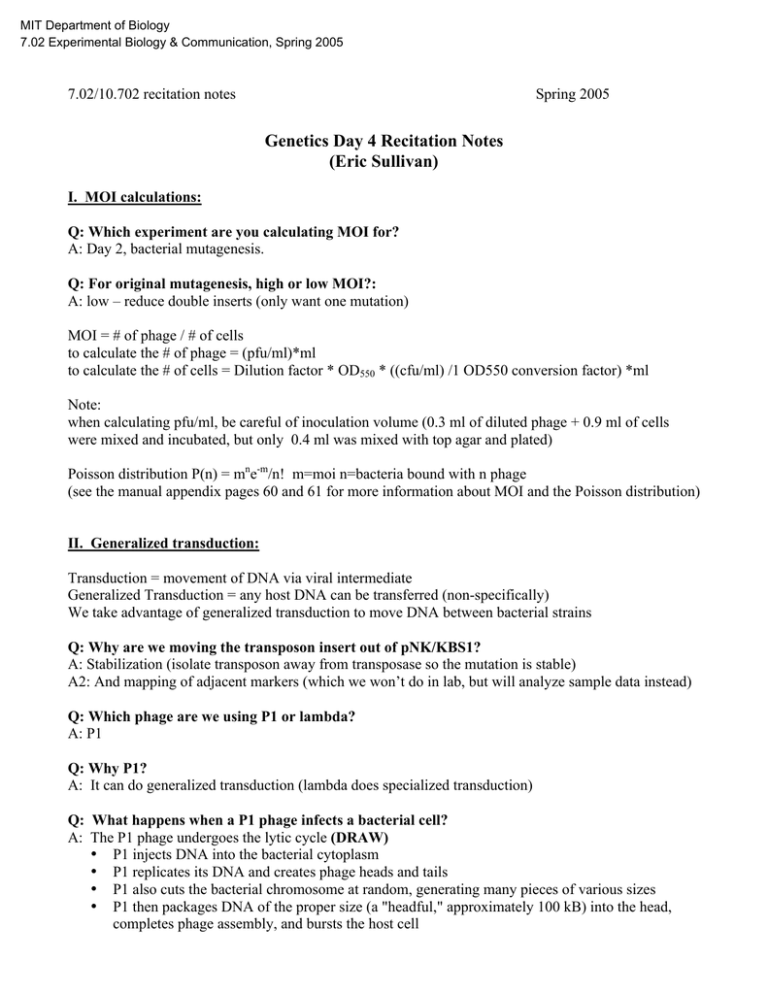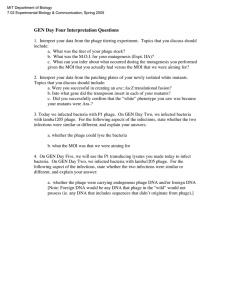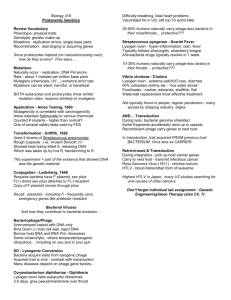Genetics Day 4 Recitation Notes (Eric Sullivan)
advertisement

MIT Department of Biology 7.02 Experimental Biology & Communication, Spring 2005 7.02/10.702 recitation notes Spring 2005 Genetics Day 4 Recitation Notes (Eric Sullivan) I. MOI calculations: Q: Which experiment are you calculating MOI for? A: Day 2, bacterial mutagenesis. Q: For original mutagenesis, high or low MOI?: A: low – reduce double inserts (only want one mutation) MOI = # of phage / # of cells to calculate the # of phage = (pfu/ml)*ml to calculate the # of cells = Dilution factor * OD550 * ((cfu/ml) /1 OD550 conversion factor) *ml Note: when calculating pfu/ml, be careful of inoculation volume (0.3 ml of diluted phage + 0.9 ml of cells were mixed and incubated, but only 0.4 ml was mixed with top agar and plated) Poisson distribution P(n) = mne-m/n! m=moi n=bacteria bound with n phage (see the manual appendix pages 60 and 61 for more information about MOI and the Poisson distribution) II. Generalized transduction: Transduction = movement of DNA via viral intermediate Generalized Transduction = any host DNA can be transferred (non-specifically) We take advantage of generalized transduction to move DNA between bacterial strains Q: Why are we moving the transposon insert out of pNK/KBS1? A: Stabilization (isolate transposon away from transposase so the mutation is stable) A2: And mapping of adjacent markers (which we won’t do in lab, but will analyze sample data instead) Q: Which phage are we using P1 or lambda? A: P1 Q: Why P1? A: It can do generalized transduction (lambda does specialized transduction) Q: What happens when a P1 phage infects a bacterial cell? A: The P1 phage undergoes the lytic cycle (DRAW) • P1 injects DNA into the bacterial cytoplasm • P1 replicates its DNA and creates phage heads and tails • P1 also cuts the bacterial chromosome at random, generating many pieces of various sizes • P1 then packages DNA of the proper size (a "headful," approximately 100 kB) into the head, completes phage assembly, and bursts the host cell 7.02/10.702 recitation notes Spring 2005 Q: How do we use P1's life cycle to our advantage? A: Packaging of DNA by P1 is NONSPECIFIC. It packages by size, not sequence. • Each phage can carry 1-2% of genome (4.6x106 = 100kb) • About 0.1% of the time bacterial DNA is packaged, whereas the other 99.9% of the time, P1 phage DNA is packaged (DRAW) Q: How often will phage package our DNA of interest (ara::lacZ fusion)? 0.1% (probability of packaging any piece of bacterial DNA) * 1% of genome (size of piece packaged )= .001% or ~1/105 phage will carry our ara::lacZ fusion III. What type of MOI is required for each experiment in the GEN module, and why? Q: For transposon mutagenesis, high/low MOI? A: As we said before, low, because we only want one phage to infect each cell. This will result in a maximum of one insertion in each cell (one mutation). Multiple phage infections-->multiple mutations, and it may be hard to tell what mutation(s) are responsible for observed phenotypes. Q: For making lysate, high/low MOI? A: High. We want to maximize the chance that we will obtain phage that carry our bacterial DNA of interest. By using a high MOI, we ensure that every cell is lysed by at least one phage. Q: For transduction on Day 5, high/low? A: Low. In this case, we want to make sure that only one phage infects each cell. If a cell is infected by a bacterial DNA-containing phage, that DNA can recombine with the new cell's chromosome (possibly giving rise to a change in phenotype). However, if that cell is then infected by a second phage, the cell will likely be lysed (as 99.9% of all phage contain P1 DNA and therefore are lytic). You will never be able to observe that phenotypic change, as the cell would be dead! Q: Lambda1205 phage required Mg2+ for adsorption to the cell surface. What does P1 require? A: Ca2+ Q: Any other ways to transfer DNA between cells? A: transformation w/ plasmid (which you'll do in RDM) (also, conjugation) Q: How else could you analyze/map these mutants? A. Genomic PCR, which you’ll do later in RDM, to map inserts IV. Chloroform: Q: Any reagent to be especially careful w/ today? A: Chloroform. • Safety: wear gloves / glasses, only use it in the hood 7.02/10.702 recitation notes Spring 2005 IV. Chloroform (continued): Q: Why are we using it? A: completes lysis of incompletely lysed cells, and (at a lower concentration) prevents any remaining bacteria from growing • At the end of their life cycle, phage produce a protein called lysozyme that breaks down the bacterial cell wall. The cells then burst because of osmotic shock (more solutes inside the cell than outside, so water rushes in; no cell wall to keep the cell intact) • If a cell is incompletely lysed (i.e. cell wall is damaged but cell membrane hasn't been broken yet), chloroform will poke holes in the cell membrane, and allow remaining phage to be released from the cytoplasm • If any uninfected cells remain, you don't want these to grow, as they'd contaminate your transduction (the cells would be KanR but would still have pNK/transposase!). Chloroform is also antimicrobial at low concentrations.






